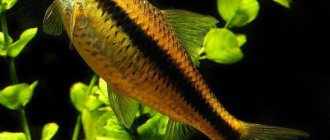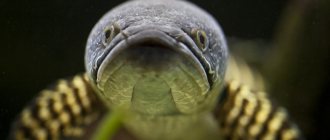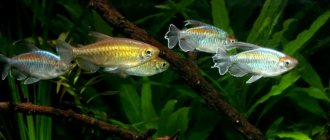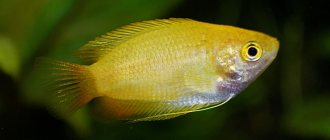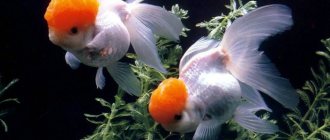General information
Astronotus is a large ray-finned fish belonging to the large Cichlid family.
This fish is also called:
- tiger astronotus;
- peacock eye;
- water buffalo;
- Oscar cichlid.
The fish attracts aquarists with its beautiful coloring, unpretentiousness and high intelligence - they say that astronotus always recognize their owner and closely observe everything that happens in the room. This species is a long-liver; in an aquarium, the fish can live for 15 years.
Description and main characteristics
Among aquarium astronotuses there are many bred varieties that differ from each other in color and some other external characteristics. But they all look like wild astronotus living in their natural environment.
Appearance
Astronotuses reach a length of 45 cm. Maximum weight is 1.5 kg. The size of fish bred in captivity depends on the volume of the aquarium. Typically, aquarium astronotuses grow up to 25-30 cm.
Features of the appearance of astronotuses:
- body - oval, laterally compressed;
- fins - large, slightly elongated;
- the anal and dorsal fin are almost connected to the tail, forming something like a “fan”;
- the head is large, pointed, with a convex forehead line;
- The mouth is large, with fleshy lips, and the teeth are medium-sized.
All of the above external signs of astronotus clearly indicate that this fish is a predator.
The body of astronotus is dark, almost black. There are red-orange spots on it in a chaotic order. It happens that they are located almost vertically and the fish has a tiger coloring. Because of this feature, astronotus received one of its names.
Another characteristic color feature is a black spot with an orange stripe at the base of the tail.
Young astronotus fish differ significantly in color from adult fish. Their spots are white, not orange-red.
Habitat in nature
Astronotus were first described at the beginning of the 19th century. South America is considered their homeland. These cichlids are found in the Amazon, as well as in other South American rivers, ponds, canals, and lakes.
The fish prefers shallow waters and waters with gentle currents. Astronotus tries to stay close to the shore, using the roots of flooded trees as shelter. In South America, astronotus is a commercial fish, as it has very tasty meat.
Astronotus, for industrial purposes, was artificially introduced into water bodies of other countries and continents - now the species is found in Australia, China, Singapore, and the southern United States. The fish adapted perfectly to new places. But then the cichlids began to dominate and displace the local representatives of the aquatic world.
Homeland of astronotus
This type of predatory fish was first described in 1831. The historical homeland of the fish is the rivers of the South American continent: Rio Negro, Amazon, Rio Paraguay and Parana.
Subsequently, the species was artificially introduced into other countries - Singapore, Guiana, Venezuela, the USA, Australia and China, where it quickly acclimatized and began to oppress the local ichthyofauna. Massive fish feel at ease in different biotopes - canals, ponds, rivers and lakes. They prefer bodies of water with weak currents and live in shallow waters. Astronotuses stay near the shore, hiding in the half-submerged rhizomes of trees.
In some South American countries, astronotus is a commercial species and is valued for the taste of juicy meat. In the USA there is even a sport fishing society for astronotus.
Popular types
Breeders have developed several forms that differ from each other in color and body shape. They continue their work to this day, developing more and more new varieties of astronotuses.
Wild
The wild astronotus, which lives in the waters of the Amazon, is dark gray in color, with a greenish tint and light stripes. A characteristic feature is the “peacock eye” at the base of the tail.
brindle
This is the most popular species among aquarists. Its scales are brown or dark gray. The spots are scattered randomly over the body. Their color is crimson or bright orange. Tiger Astronotus is not a hybrid - it can be bred in an aquarium.
The spots may have a black border, and the tail has a large black spot with an orange border - a “peacock eye”.
Gold
The golden astronotus is considered an elite species. This is a fairly rare fish, similar in appearance to the red variety. But here, instead of orange-red shades, there are golden and yellow colors.
Red
This fish is a selection form. She has orange-red spots evenly spread over a large part of her body. They are scattered in scattered places. They do not form spots or lines. Another feature of the red species is the absence of a characteristic spot in the tail.
Albino
They have a white, unpigmented body, strewn with small spots, red or bright orange. The eyes of this species are pink or orange. There is no coloring on the fins.
Lyutino
These astronotuses resemble albinos, but they have darker coloring, especially in the peacock eye area and on the fins. Their body is colored like the tiger and red astronotus.
Lemon or yellow
This is one of the most spectacular and popular types. It attracts aquarists with its unusual color. This cichlid is completely lemon yellow. The species is very rare.
Veiled
This bred form of Astronotus is distinguished from its brethren by its large, veiled fins. Their color may vary. Usually the body of the fish is painted in two primary colors that contrast with each other.
Bloody Super ed
This is the brightest and most spectacular fish among the astronotuses. It looks especially impressive against a black background. The entire body of the fish is painted a rich red color, only sometimes there is a darker shade along the edges of the fins.
Bumblebee
This astronotus received its name for its association with the coloration of a bumblebee. The body of the fish is dark gray, covered with longitudinal wide orange stripes. This species has a calmer character compared to other astronotuses.
Balloon
The second name of this astronotus is short-bodied. Due to mutations, the fish has limited spine growth and an unusually short body. Body coloration varies.
Thick-finned Astronotus
This is the closest relative of the ocellated astronotus. This is a rare and little-studied species, which, like the peacock's eye, is found in nature. The maximum length of the fish is 25 cm. The color is dark, with clear vertical stripes.
Care and maintenance
To keep astronotuses, certain conditions are needed. These fish, compared to many aquarium species, are quite large. It is with this circumstance that the main difficulties of keeping tiger cichlids are associated.
Fish selection
Since it is difficult to determine the sex of astronotus at first glance, it is better to take a group of fish - among them, with a high degree of probability, there will be both males and females.
Tips for buying cichlids:
- If you want to not only have astronotus, but also breed them, take at least 4 to 8 fish.
- The recommended size of purchased fish is 5-6 cm. If you buy smaller individuals, there is a risk that they will not be healthy enough, will have developmental defects, defects, or defects in the breed.
- Do not take fish of the same size - the chances of acquiring a group of the same sex are high.
It is recommended to keep purchased fish in a quarantine aquarium for at least 2 months.
Aquarium
Astronotus need a large aquarium. For a young couple you will need a tank of at least 100 liters. When they grow up, they will have to be moved to a larger container - about 500 liters. If you are going to breed cichlids, you need an even larger aquarium, otherwise you will inevitably end up with fierce fights among the fish.
Water
Astronotuses have no special complaints about water. Recommended water parameters:
- acidity - pH 6.0-7.5;
- temperature - +23...+28 °C;
- hardness - Gh 5-20.
It is undesirable for the water temperature to drop below +20 °C. If the thermometer drops below +13 °C, astronotuses die. To maintain the optimal temperature, the aquarium is equipped with a heater with a thermostat.
Plants and decor
Astronotuses are very large and active, so all equipment and decor in the aquarium must be securely fastened. Stones and driftwood are laid out at the bottom. Heaters can be hidden behind them so that fish do not damage them during games or fights.
Tiger cichlids, having a large weight and size, pose a threat to any equipment. They are always pushing something, turning it over, rearranging it. To reduce the risk of damage and breakdowns, it is recommended to place an object in the aquarium that would distract their attention from the equipment.
Astronotuses and plants are not compatible with each other. If you plant aquatic vegetation, then only with strong roots. Fish constantly dig in the ground, so plants should be planted not in the ground, but in separate pots. An even safer option is to use plastic algae.
The aquarium containing astronotuses must be covered with a lid. This will prevent water from splashing and fish jumping out.
Priming
The best soil for an aquarium with astronotuses is coarse sand or rolled small pebbles. It is not recommended to pour fine sand. All cichlids love to dig in the soil, so small fractions will rise up, creating turbidity in the water.
To prevent fish from injuring their mouths and faces when digging in the ground, you must use pebbles without sharp corners. You can keep astronotus in an aquarium with coarse gravel or no soil at all.
Filtration
For astronotuses, it is important that organic waste and nitrogen compounds do not accumulate in the water. A biofilter helps prevent water contamination in an aquarium.
Large astronotuses eat a lot of protein foods, so the water quickly becomes polluted with their waste products. Uneaten food makes the picture worse.
Features of filtration of an aquarium with astronotuses:
- To keep your water clean, you need a powerful filter. If you use a low-power device, harmful compounds will accumulate in the aquarium.
- It is recommended to install a pair of external filters that can provide a capacity of 7-8 aquarium volumes in 1 hour.
- It is recommended to use canister-type filters, which provide a high level of biological water purification - they are easier to maintain than their internal type counterparts.
- Tiger astronotuses need water that is well saturated with oxygen. But they do not like strong currents, so it is recommended to aerate the aquarium or supply water from an external filter through a tube that is placed above the water surface.
Filtration alone is not enough to maintain cleanliness in the aquarium; you also need to regularly change the water - at least a third of the volume every 7 days.
Feeding rules
Fish are omnivores. In nature, they eat small fish, insects, terrestrial and aquatic plants, larvae, and various invertebrates. Animal food is the basis of their diet, plants supplement it.
Rules for feeding astronotus in the aquarium:
- As the main food, it is recommended to use special dry food for large cichlids - in the form of granules or tablets.
- Frozen and live food is used as an additive to the main feed. The fish are given: crickets;
- shrimp;
- earthworms;
- squid meat;
- fish fillet;
- mussel meat;
- tadpoles;
- earthworms;
- raw beef;
- beef liver and heart;
- small fish, etc.
Compatibility
Astronotuses are completely unsuitable for general aquariums. At a young age, they can still get along with their neighbors, but gradually their character deteriorates. When they grow to a length of 10-12 cm, the fish become aggressive. It is recommended to keep a couple of cichlids in the aquarium. And if it’s a small group, then in a very large tank.
The species is considered quite peaceful, but only when adjacent to fish of similar size. Carnivorous astronotus can eat all the fish that fit in their mouths.
Suitable neighbors:
- silver arowana;
- black pacu;
- Ancistrus;
- Managuan cichlid and other large species of cichlids;
- catfish - pterygoplichthus or plecostomus.
It is not recommended to house tiger cichlids with angelfish.
Feeding
You can feed cichlids with crushed frozen or live fish, or add several live fish into the aquarium, which astronotus will enjoy eating, two or three times a day. Since these underwater inhabitants are very voracious, the portions of their food should be monitored. To correctly determine the serving size, you need to track how much the fish can eat in two minutes. This is the amount of food she should be given in the future.
Astronotuses are predators, so you should definitely include raw meat, liver or heart in your diet. It is good to give them pieces of squid, worms, flies. But if it is not possible to provide your pets with such a diet, they can also be given special food sold in pet stores.
Breeding and reproduction
There are no problems with the reproduction of astronotuses. If the couple lives in a separate aquarium and is not exposed to any stress, then spawning occurs regularly.
Sex differences
In tiger cichlids, sexual dimorphism is practically not expressed, so it is extremely difficult to distinguish males from females. It is possible to understand who is who only during the spawning period, when the females have an ovipositor.
Spawning
Sexual maturity in astronotus occurs at 2 years. From this age, fish spawn in a species aquarium - in their habitat. They don't need a spawning tank. The main thing is to create peace for the couple, since individuals are very shy and react negatively to any changes in the external environment.
If the aquarium contains fish and other species, the spawners have to be transplanted into the spawning tank:
- volume - 150 l;
- at the bottom there is a flat stone;
- water - soft, settled, with a neutral reaction;
- temperature - +26…+28 °С.
During the spawning period, the color intensity of the fish increases. At first the male behaves aggressively. Sometimes you even have to install a glass partition between the fish. After a couple of days, the male becomes calm, the pair begins to prepare the laying site - they clear an area on the bottom or on a stone.
Spawning lasts 4-5 hours. During this time, the female lays about a thousand eggs. The parents take care of the clutch - fanning them with fins and discarding spoiled eggs.
The hatched larvae turn into fry after a week. They are first fed with brine shrimp, small cyclops or daphnia. Then they are given a tubifex.
How is a male different from a female?
In normal times, it is difficult to distinguish different sexes of Astronotus from each other. Experts pay attention to the following signs:
- Astronotus males, as a rule, are larger than females (in this case, individuals of the same age are compared).
- Different-sex individuals differ in the shape of their fins. The fin on the back and near the anus of the male is longer than that of the female.
- The male's forehead is wider and has a more convex shape.
- The male's eyes are wider than the female's
- The rear body shape of females gradually becomes pear-shaped, but no such changes are observed in males.
Difficulties in content
To get and keep tiger astronotuses, desire alone is not enough. Keeping these interesting and beautiful fish is fraught with certain difficulties.
Problems with maintaining astronotuses:
- A very large aquarium is required. You should take into account the area of the room - not everywhere it is possible to install an aquarium of 500-1000 liters.
- Fish's character deteriorates with age. Keeping them in the same aquarium with other fish is problematic - conflicts and fights may arise.
- When buying and breeding cichlids, it is difficult to determine the sex - you can easily make a mistake.
Interesting Facts
Astronotus are unique fish in their own way; not only aquarists are interested in them. Some facts and information will help you learn more about these cichlids.
Interesting things about astronotuses:
- The “peacock eye” cichlid was brought to Europe in 1934, and the fish appeared in Russia 20 years later.
- These cichlids can be trained to take food from your hands. Some specimens even allow themselves to be stroked.
- In the USA, astronotus are grown on special farms for sport fishing.
- Astronotus are supplied to Russian markets by fish farms from Brazil, Guinea and Thailand.
- The fish is distinguished by its intelligence and intelligence. Aquarists claim that she has a certain intelligence. The fish not only recognize their owner, but also closely watch him from behind the aquarium glass.
Astronotuses are unusual fish that, unlike other aquarium inhabitants, can observe the lives of people and are even able to carry out the commands of their owner. Keeping such large fish requires certain conditions, so it is not recommended for beginners to keep them.
Diseases
The phenotype, thanks to artificial breeding of the species, quickly adapts and rarely gets sick. However, fish are still susceptible to some diseases, and in order to properly treat them, you need to know the symptoms and signs of the disease.
Common diseases of astronotus:
- Hexamitosis - a thorough examination of the pet will help determine the disease: if a small hole appears in the gall bladder, then the fish is sick with hexamitosis. Other symptoms include refusal to eat and lethargy.
- Bug-eyed - with this disease, the astronotus has a swollen belly. At the first signs of disease, the water is renewed, the quality of the food is checked, and the pet is also fed with vitamin supplements. If your stomach is very swollen, you need to consult a specialist before it becomes more swollen.
- Peptic ulcer disease - symptoms are growths or warts on the lower lip of the fish. Treatment is carried out with the help of medications.
Astronotus are attractive aquarium fish that are distinguished by their obstinate character and love of disorder. Watching pets is interesting and entertaining, and maintenance and care are simple and do not require much time and effort.
